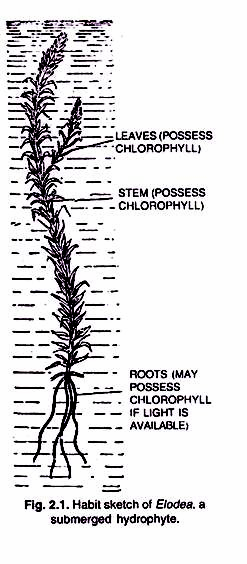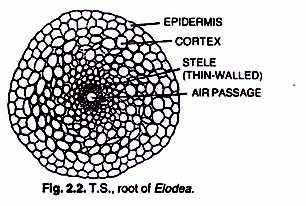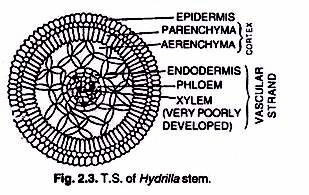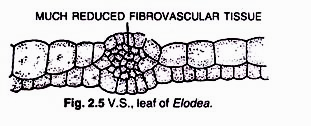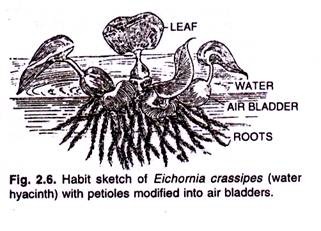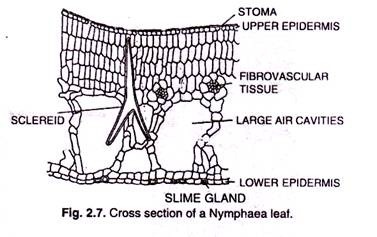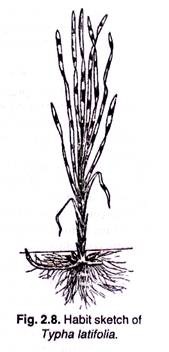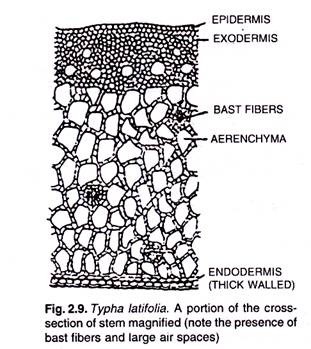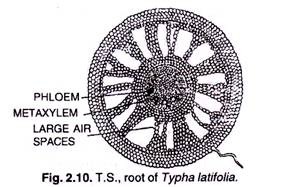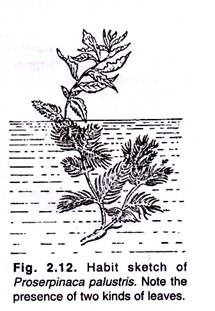ADVERTISEMENTS:
Let us make an in-depth study of the morphology and anatomy of the three groups of hydrophytes.
The three groups of hydrophytes are: (1) Submerged Hydrophytes (2) Free-Floating Hydrophytes and (3) Amphibious Plants.
Group # I. Submerged Hydrophytes:
Entire body of submerged hydrophytes remain embedded in the water column and show following morphological adaptation (Fig. 2.1):
(i) Root System:
ADVERTISEMENTS:
1. Root system of submerged plants is greatly reduced.
2. Root-hairs are absent and the aquatic roots usually possess root pockets (e.g., Eichornia speciosa).
3. The cuticle is either altogether absent (See fig. 2.2) or very poorly developed. This enables the root to absorb water directly through its surface.
4. The cortex is very well-developed and possesses large air spaces. Air present in the air spaces is used in respiration. Cells of the cortex are thin and parenchymatous.
ADVERTISEMENTS:
5. The vascular tissue is feebly developed and does not show much differentiation of tissues. Usually the cells of the vascular strand are thin walled. Sometimes the centre of the vascular strand is occupied by an air cavity.
6. Roots may contain chlorophyll if they receive sufficient light.
(ii) Stem:
1. Stem is usually weak and flexible. Sometimes it is covered by a gelatinous sheath which serves as protection against periodic desiccation.
2. The cuticle is either altogether absent or very poorly developed. The epidermis is always single-layered and thin-walled; this character facilitates direct absorption of gases and mineral salts dissolved in water.
3. The cortex is very broad and occupies bulk of the stem. The outer layers of the cortex are parenchymatous and usually without inter-cellular air spaces, whereas the inner cortex is aerenchymatous and possesses symmetrically arranged large air spaces. The air filled in these cavities adds to the buoyancy of the plant and secondly facilitate the exchange of gases during respiration and photosynthesis. (See Figs. 2.3 and 2.4)
4. The cells of the cortex contain chloroplasts and assist in carbon assimilation.
5. Usually there is no marked distinction of endodermis and pericycle. Sometimes the inner-most layer of the cortex is regarded as endodermis (See fig. 2.3).
ADVERTISEMENTS:
6. Vascular tissue is poorly developed and does not show marked differentiation of phloem and xylem. An air cavity is mostly present in the centre of the vascular strand that adds to the buoyancy of the plant. Sometimes, xylem is represented by a single strand present in the centre of the stele (e.g., Hydrilla, Potamogeton, Elodea etc.)
7. There is no mechanical tissue present in the stem of the submerged plant. Water column itself provides mechanical support to the plant.
(iii) Leaf:
1. The leaves are usually modified, thin, dissected or ribbon’ shaped. For instance, in Hydrilla and Elodea (Fig. 2.5) the leaves are small and reduced, in Potamogeton and Vallisneria these are long and ribbon- shaped, where as in Ceretophyllum the leaves are segmented.
ADVERTISEMENTS:
2. Leaves do not possess cuticle, and stomata are also absent. Exchange of gases may take place directly through surface layers.
3. There is no marked differentiation of tissues in the mesophyll. Sometimes, air spaces may be present in the mesophyll (e.g., Potamogeton, Pontedaria). Chloroplasts are present in the mesophyll cell thus enabling this tissue to conduct photosynthesis.
4. Leaf possesses a reduced fibro-vascular bundle.
ADVERTISEMENTS:
Physiological adaptation : Submerged aquatic plants obtain oxygen used in respiration from that dissolved in water or from their own photosynthesis. These plants may also respire anaerobically for considerable periods of time, but will not thrive without free oxygen.
Group # II. Free-Floating Hydrophytes:
Plants of this group remain floating on the surface of the water, but in some species the roots remain embedded in the mud and only leaves and flowers float on the surface of water (e.g., Nymphaea, Limnanthemum, Victoria regia, Euryale ferox).
Following are the important adaptations of these plants:
(i) Roots:
ADVERTISEMENTS:
1. The roots are feebly developed and are in the process of disappearance. For instance in Spirodela, there are several roots, but Lemna possesses only one root, and in Wolffia roots are altogether absent.
2. Roots are mostly hairless but do possess characteristic root-pockets, which closely resemble with the root caps of mesophytic plants. This character provides a club that hydrophytic plants have probably evolved from mesophytic ones.
3. The epidermis is single-layered and thin-walled. It does not possess any cuticle and is thus able to absorb water and minerals directly from the surrounding medium.
4. Cortex is well developed and possesses air cavities.
5. The mechanical tissue is mostly absent.
6. The centrally situated vascular strand is either undifferentiated or very poorly differentiated into xylem and phloem. In Lemna, there is no distinct vascular tissue in the root.
(ii) Stem:
ADVERTISEMENTS:
1. Internally the stem or rhizome may be very well differentiated. For example, in Nymphaea, the stem shows well differentiated epidermis, hypodermis, cortex and vascular bundles.
2. The epidermis is thin-walled and single-layered. Cells of the epidermis are mucilagenous. Cuticle is absent.
3. Cortex occupies bulk of the stem and possesses large air spaces. The air filled in these spaces helps in respiration and adds to the buoyancy of the floating plant. The cells of the cortex are always thin-walled and may even possess chloroplasts if light it available.
4. A large number of stellate sclereids may be present associated with the air spaces in the cortex. Function of these sclereids is purely mechanical. No other mechanical structure or tissue is present in the stem.
5. Vascular bundles are found scattered among the cortical cells. The vascular tissue is poorly differentiated into xylem and phloem. The xylem vessels are thin- walled and the phloem is represented by only few narrow sieve-tubes.
(iii) Leaves:
1. As the leaves are the chief organs of floating, very loose tissue with large air spaces is found in the leaf blades. Such a tissue enables the leaves to float on the surface of the water. The bulbous petiole of the water hyacinth is occupied largely by air spaces and presents a striking case of the development of floating tissue (see Fig. 2.6).
ADVERTISEMENTS:
2. The leaf possesses distinct epidermis, but the cuticle is always absent. Waxy coating may be present on the upper surface of the leaf which prevents the wetting of upper surface and clogging of the stomata by water.
3. The stomata are restricted to the upper epidermis of the leaf.
4. The mesophyll may be well differentiated into the palisade tissue and the spongy tissue (see fig. 2.7). The spongy tissue possesses large air spaces filled with air.
5. The fibro-vascular bundles are poorly developed.
6. Stellate sclereids may be present scattered in the mesophyll; their function is purely mechanical.
Group # III. Amphibious Plants:
Amphibious or emergent plants grow up into the air, but the roots of rhizomes are anchored in the mud, perhaps beneath a foot or so of shallow water. Thus, plants of this group are adapted to live partly in water and partly in air. The vascular plants of this group are the least specialized of water plants and are closely related to mesophytes.
Development of the root system, number of root hairs and degree of branching is directly proportional to decrease in water content of the habitat and increase in aeration. For instance, Typha, an emergent plant, exhibits both mesophytic (i.e., well developed mechanical and vascular tissues. See Figs. 2.8 and 2.9) as well as hydrophytic characters (i.e., prominant air-cavities and storage parenchyma) in its roots (Fig. 2.10) and stem (Fig. 2.9). Because of the abundance of mechanical tissue the amphibious plants are able to grow erect without being supported by water.
The leaves of amphibious plants show great variations in form and structure. If the leaves have developed under water, they show characteristics of submerged leaves. While they have developed in air they show marked differentiation of mesophyll, presence of stomata and fibro-vascular bundles.
Cuticle may also be present. Ranunculus aquatilis and Proserpinaca palustris exhibits interesting heterophylly. Submerged leaves of these plants are finely dissected, whereas the aerial leaves are thin and entire (See figs. 2.11 & 2.12).
The rhizome, roots, and other submerged part of amphibious plants are in large degree independent of the oxygen in the surrounding water. Most such organs are able to carry on aerobic respiration because free oxygen diffuses downward from the aerial organs of the plant through air passages in the leaves and stems. The oxygen is in part derived from atmosphere and in part from photosynthesis.
The common amphibious plants are:
Ranunculus aquatilis, Sagittaria, Alisma, Limnophylla heterophylla, Myriophyllum heterophyllum, Typha latifolia, Castalia, Cardenthera triflora, Proserpinaca palustris, Radicula aquatica, Sium acutaefolium etc.

